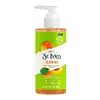What's inside
What's inside
 Key Ingredients
Key Ingredients

 Benefits
Benefits

 Concerns
Concerns

 Ingredients Side-by-side
Ingredients Side-by-side

Water
Skin ConditioningCocamidopropyl Betaine
CleansingDipropylene Glycol
HumectantHydroxypropyl Methylcellulose
Emulsion StabilisingPanthenol
Skin ConditioningSodium Chloride
MaskingC12-14 Pareth-12
EmulsifyingPhenoxyethanol
PreservativeDisodium EDTA
Ethylhexylglycerin
Skin ConditioningTocopheryl Acetate
AntioxidantPropanediol
SolventPrunus Armeniaca Fruit Extract
Skin ConditioningCI 17200
Cosmetic ColorantCI 19140
Cosmetic ColorantParfum
MaskingLinalool
PerfumingLimonene
PerfumingBenzyl Salicylate
PerfumingHexyl Cinnamal
PerfumingGeraniol
PerfumingWater, Cocamidopropyl Betaine, Dipropylene Glycol, Hydroxypropyl Methylcellulose, Panthenol, Sodium Chloride, C12-14 Pareth-12, Phenoxyethanol, Disodium EDTA, Ethylhexylglycerin, Tocopheryl Acetate, Propanediol, Prunus Armeniaca Fruit Extract, CI 17200, CI 19140, Parfum, Linalool, Limonene, Benzyl Salicylate, Hexyl Cinnamal, Geraniol
Water
Skin ConditioningSodium Laureth Sulfate
CleansingSodium Chloride
MaskingCocamidopropyl Betaine
CleansingGlycerin
HumectantSodium Benzoate
MaskingPhenoxyethanol
PreservativeDisodium Cocoyl Glutamate
CleansingCocamide Mea
EmulsifyingCitric Acid
BufferingSodium Lauroyl Oat Amino Acids
CleansingPotassium Sorbate
PreservativeDisodium EDTA
Butylene Glycol
HumectantSqualane
EmollientEthylhexylglycerin
Skin ConditioningCeramide NP
Skin ConditioningGarcinia Mangostana Peel Extract
Skin ConditioningCentella Asiatica Extract
CleansingPolygonum Cuspidatum Root Extract
AntioxidantScutellaria Baicalensis Root Extract
AstringentCamellia Sinensis Leaf Extract
AntimicrobialChamomilla Recutita Flower Extract
MaskingGlycyrrhiza Glabra Root Extract
BleachingRosmarinus Officinalis Leaf Extract
AntimicrobialAloe Barbadensis Leaf Juice
Skin ConditioningWater, Sodium Laureth Sulfate, Sodium Chloride, Cocamidopropyl Betaine, Glycerin, Sodium Benzoate, Phenoxyethanol, Disodium Cocoyl Glutamate, Cocamide Mea, Citric Acid, Sodium Lauroyl Oat Amino Acids, Potassium Sorbate, Disodium EDTA, Butylene Glycol, Squalane, Ethylhexylglycerin, Ceramide NP, Garcinia Mangostana Peel Extract, Centella Asiatica Extract, Polygonum Cuspidatum Root Extract, Scutellaria Baicalensis Root Extract, Camellia Sinensis Leaf Extract, Chamomilla Recutita Flower Extract, Glycyrrhiza Glabra Root Extract, Rosmarinus Officinalis Leaf Extract, Aloe Barbadensis Leaf Juice
 Reviews
Reviews

Ingredients Explained
These ingredients are found in both products.
Ingredients higher up in an ingredient list are typically present in a larger amount.
Cocamidopropyl Betaine is a fatty acid created by mixing similar compounds in coconut oil and dimethylaminopropylamine, a compound with two amino groups.
This ingredient is a surfactant and cleanser. It helps gather the dirt, pollutants, and other impurities in your skin to be washed away. It also helps thicken a product and make the texture more creamy.
Being created from coconut oil means Cocamidopropyl Betaine is hydrating for the skin.
While Cocamidopropyl Betaine was believed to be an allergen, a study from 2012 disproved this. It found two compounds in unpure Cocamidopropyl Betaine to be the irritants: aminoamide and 3-dimethylaminopropylamine. High-grade and pure Cocamidopropyl Betaine did not induce allergic reactions during this study.
Learn more about Cocamidopropyl BetaineDisodium EDTA plays a role in making products more stable by aiding other preservatives.
It is a chelating agent, meaning it neutralizes metal ions that may be found in a product.
Disodium EDTA is a salt of edetic acid and is found to be safe in cosmetic ingredients.
Learn more about Disodium EDTAEthylhexylglycerin (we can't pronounce this either) is commonly used as a preservative and skin softener. It is derived from glyceryl.
You might see Ethylhexylglycerin often paired with other preservatives such as phenoxyethanol. Ethylhexylglycerin has been found to increase the effectiveness of these other preservatives.
Phenoxyethanol is a preservative that has germicide, antimicrobial, and aromatic properties. Studies show that phenoxyethanol can prevent microbial growth. By itself, it has a scent that is similar to that of a rose.
It's often used in formulations along with Caprylyl Glycol to preserve the shelf life of products.
Chances are, you eat sodium chloride every day. Sodium Chloride is also known as table salt.
This ingredient has many purposes in skincare: thickener, emulsifier, and exfoliator.
You'll most likely find this ingredient in cleansers where it is used to create a gel-like texture. As an emulsifier, it also prevents ingredients from separating.
There is much debate on whether this ingredient is comedogenic. The short answer - comedogenic ratings don't tell the whole story. Learn more about comegodenic ratings here.
The concensus about this ingredient causing acne seems to be divided. Research is needed to understand if this ingredient does cause acne.
Scrubs may use salt as the primary exfoliating ingredient.
Learn more about Sodium ChlorideWater. It's the most common cosmetic ingredient of all. You'll usually see it at the top of ingredient lists, meaning that it makes up the largest part of the product.
So why is it so popular? Water most often acts as a solvent - this means that it helps dissolve other ingredients into the formulation.
You'll also recognize water as that liquid we all need to stay alive. If you see this, drink a glass of water. Stay hydrated!
Learn more about Water